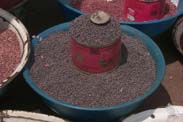Cowpea, originally inconspicuous little plants that crept among the rocks of the dusty southern Sahel in north central Africa, was domesticated thousands of years ago. Today, the genetic descendants of those wild plants are grown, as local or improved cultivars, on tens of millions of smallholder farms in the drier zones of Africa, in a great arc from Senegal eastward to Sudan and Somalia and southward to Zimbawe, Botswana and Mozambique. Two hundred million children, women and men consume cowpea often, even daily when it is available. It is widely known as a crop of the poor.
Cowpea is a nearly perfect match for the African soil, the weather, and the people.
Its grain is rich in protein and digestible carbohydrate; its energy content is nearly equal to that of cereal grains. Combined with cereals in the diet, lysine-rich cowpea complements the lysine-poor cereals, while the cereals supply the sulfur-containing amino acids needed for a balanced amino acid intake.
The tender leaves of the plant are nutritious as well; these contain 25% protein as a percentage of dry weight, and the protein quality is high. In many areas of Africa fresh leaves are regularly harvested and consumed, often as part of the typical “sauce”. The US National Aeronautics and Space Administration is so impressed with the nutritional potential of cowpea leaves that they are considering growing cowpeas in future space stations as food for astronauts. consumed, often as part of the typical “sauce”. The US National Aeronautics and Space Administration is so impressed with the nutritional potential of cowpea leaves that they are considering growing cowpeas in future space stations as food for astronauts.
In some areas of Africa, cowpeas are cooked as green pods, and the swollen beans consumed. These fresh cowpea pods, together with fresh green leaves, are the earliest foods available at the end of the “hungry time”. The succulent leaves can be harvested as soon as 21 days after planting, and cultivars are available that produce harvestable grain after only 60 days.
In many regions, cowpea hay is valued highly as fodder. This is harvested after the pods are picked. In some areas of Mali and Niger, the hay is the most valuable product of cowpea.
Like other legumes, cowpea fixes atmospheric nitrogen, and thus contributes to the available N levels in the soil. Often intercropped with sorghum, millet or maize, transfer of cowpea-fixed N to the cereal fosters cereal growth and increases yields. In farming systems where cowpea grown in monocrop is rotated with a cereal, the residual N from the cowpea benefits the cereal in the subsequent season.
One of the more remarkable things about cowpea is that it thrives in dry environments; cultivars are available that produce a good crop with as little as 300 mm of rainfall. This makes it the crop of choice for the Sahelian zone and the dry savannahs, though cultivars that flourish in the moist savannahs are available as well.
The deep root systems of cowpea help stabilize the soil, and the ground cover it provides preserves moisture; these traits are particularly important in the drier regions, where moisture is at a premium and the soil is fragile and subject to wind erosion.
Who Grows Cowpea?
The majority of cowpea growers are women. They grow cowpea because it provides food for their families, and they can sell the grain in local markets, or to traders, generating cash for household needs. The typical woman cowpea grower has a small plot, 0.25 to 1 ha., where she plants cowpea intercropped with sorghum or millet or maize.
Many men grow cowpea as well, in similar ways to those used by women. In some cowpea growing areas, men tend to grow it as a sole crop rather than as an intercrop. The grain they produce is more likely to be sold in the market or to traders, rather than consumed at home.
 The leading cowpea growing countries are Nigeria and Niger, but the land area planted to cowpea is substantial in many other nations in sub-Saharan Africa, including Senegal, Mauritania, Mali, Burkina Faso, Côte D’Ivoire, Ghana, Benin, Togo, Chad, Cameroon, Central African Republic, Congo, Sudan, Ethiopia, Kenya, Angola, Somalia, Zambia, Mozambique, Zimbabwe, Botswana, Namibia, and South Africa. The leading cowpea growing countries are Nigeria and Niger, but the land area planted to cowpea is substantial in many other nations in sub-Saharan Africa, including Senegal, Mauritania, Mali, Burkina Faso, Côte D’Ivoire, Ghana, Benin, Togo, Chad, Cameroon, Central African Republic, Congo, Sudan, Ethiopia, Kenya, Angola, Somalia, Zambia, Mozambique, Zimbabwe, Botswana, Namibia, and South Africa.
Cowpea is an important crop in some countries in Latin America, especially in northeastern Brazil. In the USA, there is considerable cowpea production in California, Texas, Arkansas and the southeastern states. Most production is for the dry grain, but in the US southeast it is grown primarily to serve the fresh and frozen market.
The Problem?
Cowpea suffers heavily from insects, both in the field as well as when the grain is stored after harvest. Graphic proof of this comes from comparing yields with and without insecticide treatments: |

